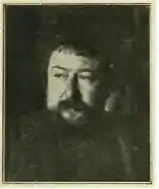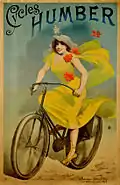Alfred Choubrac
Alfred Choubrac (Paris, 30 December 1853 – Paris, 25 July 1902) was a French painter, illustrator, draughtsman, poster artist and costume designer. Together with Jules Chéret he is considered to be one of the pioneers of the modern coloured and illustrated poster of the Belle Époque in France, in particular in Paris.
Alfred Choubrac | |
|---|---|
 Alfred Choubrac c. 1896 | |
| Born | Paris, December 30, 1853 |
| Died | Paris, July 25, 1902 (aged 48) |
| Nationality | French |
| Occupation | Painter, illustrator, draughtsman, costume designer and poster artist |

Early life
Alfred Choubrac was born in Montmartre (Paris).[1][2] With his elder brother Léon Choubrac, Alfred was trained as a classical artist with the painters Charles Doërr and Isidore Pils at the École des Beaux Arts.[3] The Choubrac brothers came very soon to the poster, practicing since 1875 the modern treatment of colors and typography, associated with images thanks to chromolithography.
In the early 1870s, the Choubrac brothers and Jules Chéret (known as "the father of the modern poster") reduced the cost of colour lithography introducing technical advances. Additionally, in 1881 restrictions on bill-posting (affichage) were lifted and eased state control of the media in France.[4][5] In 1884, the Paris city council started to rent out surfaces belonging to the municipality, paving the way for a rapid increase in the production and distribution of advertising posters. Posters with clear colours and dashing images appeared all over town during the vibrant spirit of the Belle Époque.[4]
Ateliers Choubrac
They worked mainly with the printing press F. Appel. Later, Léon and Alfred created the Ateliers Choubrac, one time hosted by the printing press G. Massias, 17 passage Daudin, one of the first graphic design agencies in Paris, operating their prints on a lithographic press. Around 1898, the name of the Atelier was associated with the name of Imprimerie Bourgerie & Cie, 83 rue du Faubourg, St Denis in Paris.[6] Although his brother Leon died young (1847-1885), Alfred went on to produce an impressive number of posters for Parisian entertainers, theatres, businesses and various commercial products.[7][8]
Alfred Choubrac specialized in posters for shows in the Parisian night-life scene of the Belle Époque, for places such as the Théâtre des Variétés, Théâtre du Châtelet, Folies Bergère, Opéra comique, Moulin rouge, Casino de Paris, the Eldorado, the Circus Fernando.[9] With Chéret and Toulouse-Lautrec, amongst others, Choubrac was among the most important poster artist of his time.[10] His most famous poster is that of Au Joyeux Moulin Rouge, based on the popular Parisian nightclub Moulin Rouge.
Censored
The 1880s and 1890s were an intermediary period in the development of the poster in which its primary political function shifted to a primarily promotional one as advertising in the emerging consumer economy, often, if not primarily, through the commoditisation of female sexuality.[5] In April 1891, under orders from the Minister of the Interior, the prefect of Paris, Henri-Auguste Lozé, seized and destroyed hundreds of posters considered to a violation of public decency. Many artists and their printers were charged. Several of Choubrac's posters were prohibited and he was brought to court along with the printers.[5][11]
One of the censored posters advertised the performance of the dancer Ilka de Mynn at the Folies Bergère, who was depicted in a maillot (body stocking), which according to the court that charged Choubrac was a cause for concern because the model appeared to be nude.[5] Another poster was an advertisement for the French magazine Fin de Siècle, which showed a scarcely dressed female dancer.[12][7] In an interview with La Presse, Choubrac said he was astonished by the upheaval, claiming that "nudity is exposed everywhere and in much more provocative ways; and I frankly confess that I do not see where the evil was, I sought to make a work of art and nothing more."[13]
 Ilka de Mynn at the Folies-Bergère, 1891
Ilka de Mynn at the Folies-Bergère, 1891 Censored poster for the French magazine Fin de Siècle, 1891
Censored poster for the French magazine Fin de Siècle, 1891 Uncensored poster for the French magazine Fin de Siècle, 1891
Uncensored poster for the French magazine Fin de Siècle, 1891 Second version for Fin de Siècle (after censored poster), 1891
Second version for Fin de Siècle (after censored poster), 1891
Other work and exhibitions
In later life he became also known for his designs of stage costumes for the theatre.[2][14] Choubrac illustrated several works by Emile Zola.[3] He carried out a number of bookstore posters to promote popular works. He also produced commercial posters for brands such as the Muscovite Digestive, Humber Cycles, Beeston Tire, Naigeon Gold Water, Unbreakable Baleinine Corsets, Mokatine, Decauville Cycles, Burgeatine Liqueur, and the Hippodrome of Saint-Ponchon, among others.
As an illustrator, he sometimes collaborated with his brother Léon in Gil Blas or the satirical weekly Le Courrier français, among others. The first poster exhibition in France occurred in 1884 in the Passage Vivienne in Paris and included American as well as French posters with specific representation of the work of Cheret and the two Choubrac brothers.[15] The New York Grolier Club in November 1890 organised an exhibition of prints of the "masters in the newest art", that of bill posting, including Choubrac, Chéret, Willette and Eugène Grasset.[16]
Legacy and death
The poster collector Ernest Maindron, who wrote the first essay about the illustrated poster in the Gazette des Beaux-Arts in 1884, and later published the first book on the subject (Les Affiches Illustrees) in 1886, mentioned the Choubrac brothers and Chéret among the pioneers of the illustrated poster.[7][17] Maindron praised Choubrac's bold line, sense of composition and highly decorative skills.
Alfred Choubrac died on 25 July 1902 from a cold gone bad.[1][18]
Selected works
 Advertising poster of Corsets Baleinine Incassables
Advertising poster of Corsets Baleinine Incassables Advertising poster Salle Wagram, 1890
Advertising poster Salle Wagram, 1890 Poster Folies Bergères Danse de la serpentine, 1890
Poster Folies Bergères Danse de la serpentine, 1890 Advertising poster of the French chansonnier Victor Lejal in the Ambassadeurs, 1890
Advertising poster of the French chansonnier Victor Lejal in the Ambassadeurs, 1890 Portrait of Eugenie Fougère, ca. 1890
Portrait of Eugenie Fougère, ca. 1890 Poster Casinos de Trouville, 1890s
Poster Casinos de Trouville, 1890s Advertising poster of Decauville cycles, c. 1892
Advertising poster of Decauville cycles, c. 1892 Advertising poster of Humber Cycles, France, 1895
Advertising poster of Humber Cycles, France, 1895 Advertising poster of the play "Orient-Express", 1896
Advertising poster of the play "Orient-Express", 1896 Poster Ohé Ohé On va ouvrir, Théatre des Folies Marigny, 1897
Poster Ohé Ohé On va ouvrir, Théatre des Folies Marigny, 1897 Advertising poster of the Hippodrome of Saint-Ponchon
Advertising poster of the Hippodrome of Saint-Ponchon Portrait of Marius Fontane in Les Hommes d'aujourd'hui n°259, 1885
Portrait of Marius Fontane in Les Hommes d'aujourd'hui n°259, 1885
References
- (in French) Nécrologie, Le Radical, 28 July 1902
- (in French) Martin, Nos peintres et sculpteurs, graveurs, dessinateurs, p. 105
- (in French) Beraldi, Les graveurs du 19e siècle, p.17
- Verhagen, The poster in Fin-de-Siècle Paris, p. 107
- Carter, Karen L. (2010). Unfit for public display: female sexuality and the censorship of fin‐de‐siècle publicity posters, Early Popular Visual Culture, 8:2, 107-124
- (in French) Ateliers Choubrac, Bibliothèque Nationale de France (BNF)
- Maindron, Les affiches Illustrées (1886-1895), p. 51-55
- Hiatt, Picture Posters, Chapter 5
- (in French) Alfred Choubrac (1853-1902), Bibliothèque Nationale de France (BNF)
- Verhagen, The poster in Fin-de-Siècle Paris, p. 109
- (in French) Les affiches obscènes, La Presse, 9 May 1891
- (in French) Rapazzini, Le Moulin Rouge en folies, p. 86
- (in French) L'affiche artistique, La Presse, 12 April 1891
- Gutsche-Miller, Sarah (2010). Pantomime-Ballet on the Music-Hall Stage: The Popularisation of Classical Ballet in Fin-de-Siècle Paris, Thesis, Schulich School of Music McGill University
- The Color Revolution: Color Lithography in France, 1890-1900
- Posters at the Grolier Club, The New York Times, November 7, 1890
- Collins, Bradford R. (1985). The Poster as Art; Jules Chéret and the Struggle for the Equality of the Arts in Late Nineteenth-Century France, Design Issues, Vol. 2, No. 1 (Spring, 1985), pp. 41-50
- (in French) Nécrologie, Le Petit Journal, 26 July 1902
- (in French) Beraldi, Henri (1886). Les graveurs du 19e siècle; guide de l'amateur d'estampes modernes, Paris: L. Conquet
- Hiatt, Charles (1896). Picture Posters, London/New York: George Bell & Sons, MacMillan & Co.
- (in French) Maindron, Ernest (1896). Les affiches Illustrées (1886-1895), Paris: G. Boudet
- (in French) Martin, Jules (1897). Nos peintres et sculpteurs, graveurs, dessinateurs, Paris: E. Flammarion
- (in French) Rapazzini, Francesco (2016). Le Moulin Rouge en folies, Paris: Cherche Midi, ISBN 9782749154244
- Verhagen, Marcus, The poster in Fin-de-Siècle Paris: "That Mobile and Degenerate Art", in: Charney, Leo & Vanessa R. Schwartz (eds.) (1995). Cinema and the Invention of Modern Life, Berkeley (CA): University of California Press, ISBN 9780520201125
| Wikimedia Commons has media related to Alfred Choubrac. |
